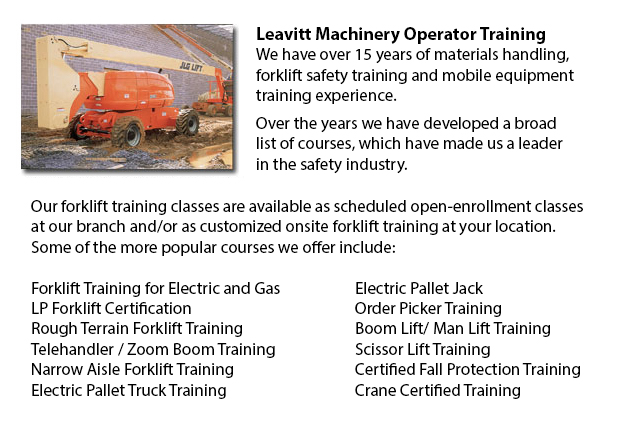
Vernon Aerial Boom Lift Training - Aerial Boom Lift Training is required for any person who supervises, operates or works near boom lifts. This particular kind of aerial lift or aerial work platform is used for lifting people, materials and tools in projects requiring a long reach. They are normally used to access other above ground job-sites and utility lines. There are various kinds of aerial booms lifts, like articulating boom lifts, extension boom lifts and cherry pickers. There are two types of boom lift: "knuckle" and "telescopic".
Boom lift training is important and normally involves the fundamental operations, equipment and safety issues. Workers are needed while working with mobile machines to understand the rules, dangers, and safe work practices. Training course materials offer an introduction to the applications, terms, concepts and skills necessary for employees to obtain competence in operating boom lifts. The material is aimed at equipment operators, safety experts and workers.
This training is adaptive, cost-effective and educational for your company. A safe and effective workplace could help a company attain overall high levels of production. Less workplace accidents occur in workplaces with stringent safety rules. All equipment operators must be trained and assessed. They require understanding of current safety measures. They should comprehend and follow rules set forth by the local governing authorities and their employer.
It is the employer's responsibility to ensure that employees who are required to make use of boom lifts are trained in their safe use. Each different type of workplace equipment needs its own machine operator certification. Certifications are offered for articulating booms, aerial work platforms, scissor lifts, industrial forklift trucks, and so forth. Completely trained employees work more effectively and efficiently compared to untrained employees, who need more supervision. Correct training and instruction saves resources in the long run.
Training is the best prevention for the primary causes of workplace fatalities: electrocutions, falls and collapses or tip overs. Aside from training, the best way to avoid workplace accidents is to operate and maintain aerial work platforms based on the instructions of the manufacturer. Allow for the total weight of the tools, materials and the worker when following load restrictions. Never override mechanical, electrical or hydraulic safety devices. Workers should be held securely in the basket utilizing a body harness or restraining belt with an attached lanyard. Do not move lift machinery whilst employees are on the elevated platform. Employees must take care not to position themselves between the joists or beams and basket rails in order to avoid being crushed. Energized overhead power lines should be at least 10 feet away from the lift machinery. It is recommended that employees always assume power lines and wires might be energized, even if they seem to be insulated or are down. If working on an incline, set brakes and use wheel chocks.
-
Vernon Heavy Equipment Training Programs
Vernon Heavy Equipment Training Programs - At whatever given construction site, there are often different types of machinery which are ready to be used. These heavy and light machines need both operators to run them and mechanics to fix them. Trainee... More -
Vernon Forklift Safety Training
Vernon Forklift Safety Training - People wanting work in industries that operate lift trucks should undergo a forklift safety training program before becoming a certified operator of a lift truck. There are a lot of ways to go about acquiring forklif... More -
Vernon Aerial Boom Lift Ticket
Vernon Aerial Boom Lift Ticket - Aerial platform lifts can accommodate various odd jobs involving high and tough reaching places. Normally used to complete regular preservation in structures with tall ceilings, prune tree branches, elevate heavy shel... More -
Vernon Manlift Safety Training
Vernon Manlift Safety Training - Manlift operators need to be cognizant and aware of all the potential dangers which are associated with particular classes of scissor lifts. They need to be able to operate the scissor lift in a way that protects not... More -
Vernon Forklift License
Vernon Forklift License - Obtaining a forklift certification or forklift license in North America will require the one training to carry out hands-on training in addition to classroom instruction. The provincial, federal and state regulatory bodies a... More -
Narrow Aisle Forklift, Order Picker, Electric Pallet Jack, Electric Pallet Truck Certification in Vernon
A pallet lift is a model of equipment dedicated in the transporting of pallets of many dimensions and weights. They can be utilized as an appendage for forklifts, cranes and other styles of heavy machinery or be applied on their own. Pallet hoists ar... More -
Vernon Boom Lift Safety Training
Vernon Boom Lift Safey Training - Boom lifts are a type of elevated work platform or aerial lifting device which are commonly utilized in construction, industry, and warehousing. Boom lifts can be utilized in practically any surroundings because of t... More -
Vernon Manlift Operator Training
Vernon Manlift Operator Training - The aerial lift or manlift is a specialized kind of hydraulic platform that is designed to lift a person vertically giving it an alternate name of a vertical personnel lift. These machinery are widely utilized for a... More

Forklift Certification Vernon
TOLL FREE: 1-888-254-6157
Vernon, British Columbia
forkliftcertificationvernon.com
Email Us
About Us


